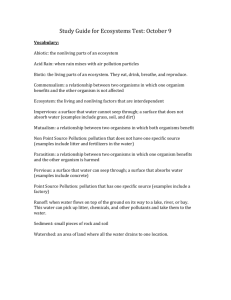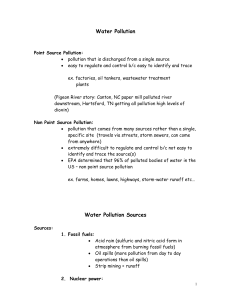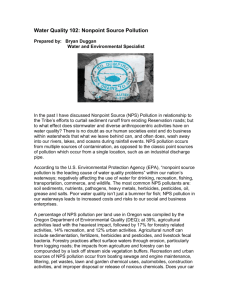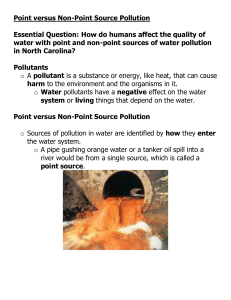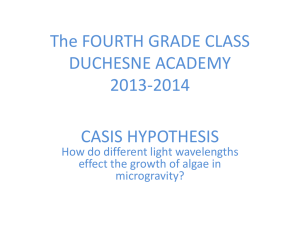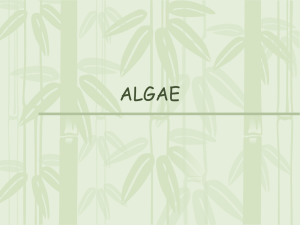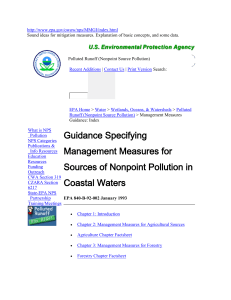Non-point Source Pollution
advertisement
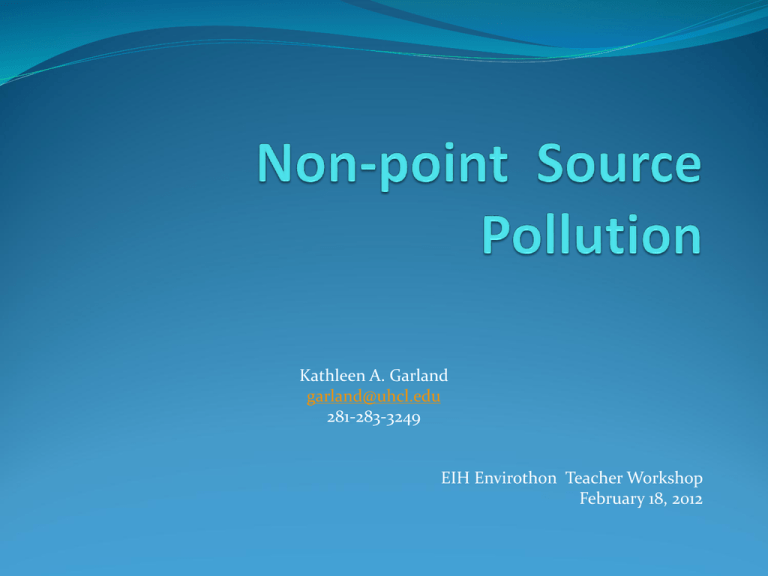
Kathleen A. Garland garland@uhcl.edu 281-283-3249 EIH Envirothon Teacher Workshop February 18, 2012 What’s a point source? Industrial or municipal discharge End-of-pipe The key concepts for understanding point source pollution Channelized flow It has a distinct source You can identify that source You can control that source Non-point source pollution No specific source location Acid mine drainage A map of eastern streams impacted by coal mine drainage Agricultural runoff During storms Runoff from livestock Concentrated animal feeding operations Urban stormwater runoff Characteristics of Non-point source Sheet flow No identified point where all discharge takes place Source generally cannot be directly controlled What’s in the water? Debris Sediment in stormwater Chemicals of concern: Metals COC’s: oils and greases Thermal pollution Nutrients What are nutrients? Things that make plants grow… Nitrogen Phosphorus Potassium Algae is a plant (sort of, a Protist, actually, but close to a plant…it photosythesizes) Nutrients make algae grow—or overgrow! Not all algal blooms are green… Why is too much algae a bad thing? Eutrophication Nutrients feed algae Algae bloom, creating large amounts of biomass Algae die, sinking to the bottom of the water body Algae decay, using up the oxygen in the lower layer of the water Benthic (bottom-dwelling) organisms cannot survive Fish eat benthics, so they either move away, or they die, too Eutrophication leads to Hypoxia Hypoxia: the condition of extremely low levels of oxygen in the water In the Gulf of Mexico, we call the hypoxic zone— The Dead Zone How does the Dead Zone Form? Hypoxic zone in the GOM Source area for GOM Hypoxic Zone Global hypoxic zones Impacts of hypoxia Fisheries Affects fish stocks Affects nursery areas for future fish stocks Water quality Recreational Fishing and boating Shellfish Coral reefs Recent example: TPWD http://www.tpwd.state.tx.us/landwater/water/environ concerns/hab/redtide/status.phtml Coral reefs in the northern GOM Corals in FGBNMS Invasive species Who regulates non-point source pollution? EPA: Section 319 of the Clean Water Act http://www.epa.gov/owow_keep/NPS/cwact.html For freshwater systems Requires states to implement plan Coastal Zone Act Reauthorization Amendments (CZARA) Section 6217 http://www.epa.gov/owow_keep/NPS/czara.html Specifically relates to coastal areas—like us! Why should we care? Galveston Bay is an estuary—a drowned river basin The most productive aquatic habitats on the planet Wetlands and marshes Seabirds, turtles, shellfish, and ocean fish Extremely vulnerable to pollution from NPS Needs freshwater inflows to survive Downstream from two massive urban areas: DFW and Houston Industrial pollution Urban runoff Agricultural runoff If those inflows are nutrient loaded, the Bay suffers Chesapeake Bay A very badly damaged estuary We don’t want to get that way! What can we do to reduce NPS? Stay tuned! Dr. John Jacob, of Texas Coastal Watersheds will be speaking at 1:30 on exactly this topic!
